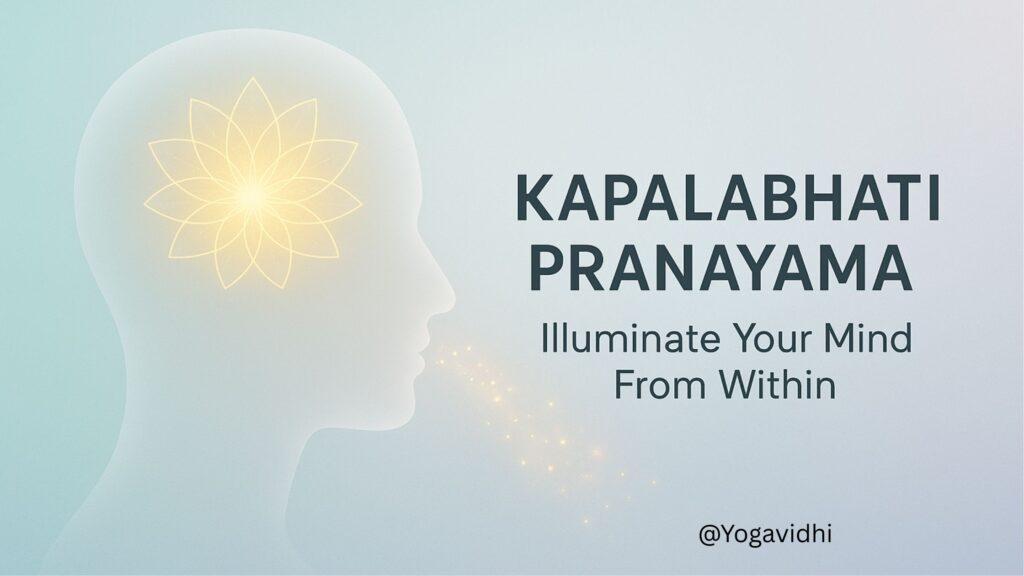Breath is life, and in yoga, mastering the breath means mastering the mind. Among the many yogic breathing practices, Kapalabhati pranayama stands out as one of the most powerful cleansing and energizing techniques. Known as the “Skull Shining Breath”, it is an ancient practice from Hatha Yoga that purifies the body, sharpens the mind, and awakens spiritual energy.
In Sanskrit, Kapal means “forehead or skull” and Bhati means “light or illumination.” Practicing Kapalabhati pranayama is said to bring clarity, radiance, and vitality — as though your very face begins to glow from within. In today’s fast-paced world, where stress, anxiety, and fatigue are common, this technique acts like a natural detox for both the body and mind.
Kapalabhati Pranayama, also known as the “Skull Shining Breath,” is a dynamic yogic breathing practice that uses strong, rapid exhalations and effortless inhalations driven mainly by the abdominal muscles. This powerful technique is celebrated for its purifying and revitalizing impact on both the body and mind.
Table of Contents
What is Kapalabhati Pranayama?
Kapalabhati pranayama is a yogic breathing technique that involves short, powerful exhalations and passive inhalations. Unlike normal deep breathing, where both inhalation and exhalation are slow and controlled, Kapalabhati emphasizes forceful exhalation, almost like a rhythmic cleansing pump for the lungs.
Many people confuse Kapalabhati with Bhastrika pranayama, but there’s a key difference:
- Kapalabhati focuses on active exhalation and passive inhalation.
- Bhastrika focuses on active inhalation and exhalation (both forceful).
This unique pattern of Kapalabhati makes it more of a shatkarma kriya (yogic cleansing technique) than just a breathing exercise.
The Science Behind Kapalabhati Pranayama
The effects of Kapalabhati pranayama go far beyond just breathing. When practiced regularly, it:
- Clears carbon dioxide and toxins from the lungs.
- Increases oxygen supply to the brain and body.
- Stimulates the abdominal organs and improves digestion.
- Activates the parasympathetic nervous system, calming the mind.
Research suggests that Kapalabhati pranayama improves pulmonary function, enhances concentration, and reduces stress markers in the body. By flushing out stale air and toxins, it rejuvenates cells and makes the entire system more efficient.
How to Practice Kapalabhati Pranayama (Step-by-Step Guide)
If you’re a beginner, here’s a simple step-by-step guide to practice Kapalabhati pranayama correctly:
- Sit in a comfortable posture – Choose Padmasana (Lotus Pose), Sukhasana (Easy Pose), or Vajrasana (Thunderbolt Pose). Keep your spine straight.
- Place your hands in a mudra – Rest your palms on your knees in Gyan Mudra (thumb and index finger touching).
- Take a deep breath in – Fill your lungs gently.
- Forcefully exhale through the nose – Pull your navel inward toward your spine with each exhalation.
- Allow passive inhalation – After every exhalation, let the breath naturally flow back in without effort.
- Continue in rhythm – Start with 20–30 strokes (one stroke = one exhalation and passive inhalation).
- Complete 3 rounds – Take a short pause after each round, breathing normally.
Best Time to Practice: Early morning on an empty stomach for maximum benefits.
Benefits of Kapalabhati Pranayama
1. Physical Benefits
- Detoxifies the lungs – Flushes out carbon dioxide and toxins from the respiratory system.
- Strengthens the diaphragm & abdomen – Tones abdominal muscles and stimulates digestive organs.
- Boosts metabolism – Aids in weight management and fat reduction.
- Improves circulation & immunity – Enhances blood flow and energizes the body.
2. Mental Benefits
- Sharpens concentration – Increases mental clarity and memory.
- Reduces stress & fatigue – Releases mental tension and calms the nervous system.
- Elevates mood – Promotes positivity and emotional stability.
3. Spiritual Benefits
- Awakens prana (life force) – Energizes the subtle body and chakras.
- Activates the Ajna Chakra (Third Eye) – Enhances intuition and inner wisdom.
- Prepares for meditation – Calms the mind and creates inner stillness.
Regular practice of Kapalabhati pranayama truly makes you feel lighter, brighter, and more connected with your inner self.
Precautions and Contraindications
While Kapalabhati pranayama has immense benefits, it’s not suitable for everyone. You should avoid or consult a yoga expert if you:
- Have high blood pressure or heart disease.
- Suffer from asthma, bronchitis, or respiratory disorders.
- Are pregnant or menstruating.
- Recently underwent abdominal or chest surgery.
Beginners should always start slowly under proper guidance to avoid overexertion.
Read More: Morning Yoga: Start Your Day with Energy, Clarity, and Calm
Read More: Sivananda Yoga: A Holistic Path to Inner Peace, Health & Self-Realization
Common Mistakes to Avoid
Many practitioners unknowingly make mistakes while practicing Kapalabhati pranayama:
- Breathing too fast without rhythm.
- Straining the chest instead of engaging the abdomen.
- Practicing immediately after eating.
- Hunching the back instead of keeping the spine straight.
Correct technique is essential to unlock the true benefits.
| Aspect | Details |
| Meaning | Kapal = Skull, Bhati = Shining → “Skull Shining Breath” |
| Type | Yogic Breathing Technique (Pranayama & Shatkarma Kriya) |
| Technique | Forceful exhalation through the nose, passive inhalation |
| Posture | Padmasana, Sukhasana, or Vajrasana with straight spine |
| Mudra | Gyan Mudra (thumb and index finger joined) |
| Best Time to Practice | Morning, on an empty stomach |
| Beginner Practice | 20–30 strokes per round, 2–3 rounds |
| Advanced Practice | 60–80 strokes per round with Kumbhaka (retention) & Bandhas (energy locks) |
| Physical Benefits | Detoxifies lungs, strengthens abdomen, improves digestion, boosts metabolism, enhances immunity |
| Mental Benefits | Improves concentration, reduces stress, calms the mind, enhances memory |
| Spiritual Benefits | Awakens prana (life force), activates Ajna Chakra (third eye), prepares for meditation |
| Contraindications | Avoid if you have high BP, heart problems, respiratory disorders, pregnancy, or recent surgery |
| Common Mistakes | Practicing on full stomach, overexertion, hunching back, incorrect rhythm |
| Comparison | Kapalabhati: Active exhalation, passive inhalation. Bhastrika: Active inhalation & exhalation |
| Duration | 5–10 minutes daily (gradually increasing) |
| FAQs | Weight loss support, reduces anxiety, not recommended during menstruation |
Kapalabhati Pranayama for Beginners
If you’re new to pranayama, here’s how to start:
- Begin with 30 strokes per round at a slow pace.
- Gradually increase to 60–80 strokes as your stamina improves.
- Focus on quality over speed – rhythmic, forceful exhalations with relaxed inhalations.
- Use guided audio or a yoga teacher for correct rhythm.
With consistency, beginners can safely master Kapalabhati pranayama within weeks.
Advanced Practice & Variations
Once you’re comfortable, you can explore advanced levels:
- Kapalabhati with Kumbhaka (breath retention) – Retain the breath after exhalation for deeper impact.
- Bandhas (energy locks) – Combine with Mula Bandha (root lock), Uddiyana Bandha (abdominal lock), and Jalandhara Bandha (throat lock).
- Integration with other pranayama – Practice Kapalabhati followed by Anulom Vilom, Nadi Shodhana, or Bhastrika for balance.
Kapalabhati vs. Other Pranayamas
- Kapalabhati vs Bhastrika: Kapalabhati is exhale-focused, while Bhastrika involves forceful inhalation and exhalation.
- Kapalabhati vs Nadi Shodhana: Kapalabhati detoxifies and energizes, whereas Nadi Shodhana balances and calms.
- Kapalabhati as Shatkarma: Unlike most pranayamas, Kapalabhati is also a cleansing technique (shatkarma kriya) that purifies the body from within.
Daily Routine with Kapalabhati
For best results, integrate Kapalabhati into your daily yoga practice:
- Morning sequence: Start with Kapalabhati → move to Anulom Vilom → end with meditation.
- Duration: 5–10 minutes daily is sufficient for beginners.
- Consistency: Practicing regularly is more important than intensity.

Conclusion
Kapalabhati pranayama is more than just a breathing technique — it’s a holistic practice that cleanses, energizes, and uplifts body, mind, and spirit. With its unique ability to detoxify the system, sharpen focus, and awaken inner energy, it is truly the jewel of yogic pranayama.
Whether you want better health, mental clarity, or spiritual growth, dedicating just a few minutes daily to Kapalabhati pranayama can transform your life. Start small, stay consistent, and let your inner light shine through.
Breathe with awareness, exhale the toxins, and illuminate your path with the radiance of Kapalabhati.
FAQs about Kapalabhati Pranayama:
Q. How many minutes should one do Kapalabhati pranayama daily?
Ans: Beginners can start with 2–3 minutes and gradually increase to 10–15 minutes daily.
Q. Is Kapalabhati pranayama good for weight loss?
Ans: Yes, it boosts metabolism, tones abdominal muscles, and aids in fat reduction naturally.
Q. Can Kapalabhati pranayama help with anxiety and depression?
Ans: Absolutely. It calms the nervous system, reduces stress hormones, and improves mental clarity.
Q. Is Kapalabhati safe during menstruation?
Ans: It’s generally not recommended, as the forceful abdominal contractions may cause discomfort.
Q. Can beginners practice Kapalabhati safely?
Ans: Yes, but under guidance and with slow progression to avoid strain.
Q. What is Kapalbhati Pranayama?
Ans: Kapalbhati Pranayama is a yogic breathing practice that involves forceful exhalations followed by passive inhalations. Commonly known as the “skull-shining breath,” it is a powerful technique that helps cleanse and energize both the mind and body.
Q. What is Kapalbhati also known as?
Ans: Kapalbhati, also called the Skull Shining Breathing Technique or Bhalabhati, is a unique form of pranayama (yogic breathing practice) that emphasizes powerful exhalations followed by effortless inhalations. The word “Kapalbhati” translates to “skull shining” or “illuminating the skull,” highlighting its purifying and cleansing impact on the head and surrounding organs.
Q. What is the history of Kapalbhati Pranayama?
Ans: Kapalbhati Pranayama has its roots in ancient Indian traditions and scriptures. It is referenced in the Hatha Yoga Pradipika, a renowned text on Hatha Yoga composed in the 15th century by Swami Swatmarama.
Q. Which disease is treated by kapalbhati?
Ans: It enhances the functioning of the lungs and kidneys while aiding in the removal of ama (toxins) by purifying the body from within. It also boosts blood circulation and increases oxygen supply throughout the body. Additionally, it stimulates the abdominal organs and helps in relieving constipation, acidity, sinus issues, and diabetes.
Declaration Note:
We use third-party videos and images on https://yogavidhi.com/ for educational and illustrative purposes. All rights belong to their respective owners. No copyright infringement is intended.



